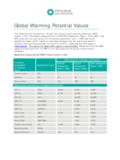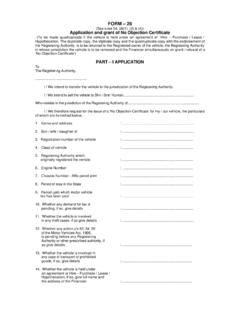Transcription of Rev. Proc. 2015-28
1 1 Rev. Proc. 2015 -28 SECTION 1. PURPOSE The Employee Plans Compliance Resolution System ( EPCRS ) sets forth a comprehensive system of correction programs for sponsors of retirement plans that are intended to satisfy the requirements of 401(a), 403(a), 403(b), 408(k), or 408(p) of the Internal Revenue Code ("Code"), but that have failed to meet those requirements for a period of time. The components of EPCRS are the Self-Correction Program ("SCP"), the Voluntary Correction Program ("VCP"), and the Audit Closing Agreement Program ("Audit CAP"). EPCRS permits plan sponsors to correct failures and thereby continue to provide employees with retirement benefits on a tax-favored basis. The most recent restatement of EPCRS is set forth in Rev. Proc. 2013-12, 2013-4 313. The following modifications to Rev. Proc. 2013-12 are reflected in this revenue procedure: New safe harbor EPCRS correction methods relating to automatic contribution features (including automatic enrollment and automatic escalation of elective deferrals) in plans described in 401(k) and 403(b); and Special safe harbor correction methods for plans (including those with automatic contribution features) that have failures that are of limited duration and involve elective deferrals.
2 SECTION 2. BACKGROUND .01 Section of Rev. Proc. 2013-12 provides that it is expected that the EPCRS revenue procedure will continue to be updated, in whole or in part, from time to time, including in response to questions received from the public..02 Section (2) of Rev. Proc. 2013-12 specifically requested comments regarding methods to correct failures to implement automatic contribution features (including automatic escalation features that were affirmatively elected) with respect to elective deferrals in a 401(k) plan or a 403(b) Plan..03 The Internal Revenue Service ( Service ) has received comments requesting special correction methods with respect to a failure to implement automatic contribution features. Commenters have stated that the cost associated with correcting failures to implement automatic contribution features under the current rules in EPCRS, as set forth in Rev. Proc. 2013-12, discourages employers from adopting plans with automatic contribution features because implementation errors are more common for plans with automatic contribution features (particularly automatic escalation features).
3 The commenters also noted that implementation errors typically are discovered in connection with the preparation of a plan s Form 5500 series return/report for a plan year. In addition, commenters expressed the view that current EPCRS safe harbor 2 correction methods for the exclusion of eligible employees in a 401(k) plan or 403(b) Plan, or for failing to implement a salary reduction election in a 401(k) plan or 403(b) Plan, create a windfall for affected employees because those employees receive both their full salary and a 50% make-up corrective contribution. Commenters argue that this correction overcompensates affected participants for failures that last a short period of time because the participants usually have the opportunity to increase elective deferrals in later periods..04 The 50% make-up corrective contribution mentioned by commenters was first provided with respect to the improper exclusion of eligible employees in Rev. Proc. 2006-27, 2006-1 945, and was extended to failures to implement employee elections with respect to elective deferrals in Rev.
4 Proc. 2008-50, 2008-2 464. Previously, Rev. Proc. 2003-44, 2003-1 1051, had provided for a make-up corrective contribution based on the actual deferral percentage for an affected employee s group multiplied by the affected employee s compensation. The correction principle underlying the 50% make-up corrective contribution was that corrective contributions should make up for the value of the lost opportunity for an employee to have a portion of his or her compensation accumulate with earnings tax deferred in the future assuming the participant would not have the opportunity to increase elective deferrals in later periods to make up for missed contributions and earnings that would have accumulated until retirement..05 The Service is issuing this revenue procedure to improve and update EPCRS by making limited modifications to Rev. Proc. 2013-12. These modifications to EPCRS are described in Section 3, and revisions to Rev. Proc. 2013-12 implementing these modifications are set forth in Section 4.
5 06 The Treasury Department and the Service continue to invite further comments on how to improve EPCRS. For information about how to submit comments, see section 7 of this revenue procedure. SECTION 3. DESCRIPTION OF MODIFICATIONS TO EPCRS .01 Effect on programs. This revenue procedure modifies, but does not supersede, Rev. Proc. 2013-12..02 Description of special safe harbor methods to correct failures related to automatic contribution features in a 401(k) plan or 403(b) Plan. This revenue procedure modifies the safe harbor correction methods and examples in Appendices A and B to Rev. Proc. 2013-12 to provide alternative correction methods for Employee Elective Deferral Failures (as defined in section of this revenue procedure) associated with missed elective deferrals for eligible employees who are subject to automatic contribution features under 401(k) plans or 403(b) Plans (including 3 employees who made affirmative elections in lieu of automatic contributions but whose elections were not implemented correctly).
6 (1) Modified safe harbor correction method for Employee Elective Deferral Failures to implement an automatic contribution feature. If the failure to implement an automatic contribution feature for an affected eligible employee or the failure to implement an affirmative election of an eligible employee who is otherwise subject to an automatic contribution feature does not extend beyond the end of the 9 month period after the end of the plan year of the failure (which is generally the filing deadline of the Form 5500 series return, including automatic extensions), no qualified nonelective contribution ( QNEC ) (as defined in (k)-6 of the Income Tax Regulations) for the missed elective deferrals is required, provided that the following conditions are satisfied: (a) correct deferrals begin no later than the earlier of (i) the first payment of compensation made on or after the last day of the 9 month period after the end of the plan year in which the failure first occurred for the affected eligible employee or (ii) if the Plan Sponsor was notified of the failure by the affected eligible employee, the first payment of compensation made on or after the last day of the month after the month of notification; (b) notice of the failure that satisfies specified requirements in new section.
7 05(8)(c) of Appendix A of Rev. Proc. 2013-12 is given to the affected eligible employee not later than 45 days after the date on which correct deferrals begin; and (c) corrective contributions to make up for any missed matching contributions are made in accordance with timing requirements under SCP for significant operational failures (described in section of Rev. Proc. 2013-12) and are adjusted for Earnings. See section of Rev. Proc. 2013-12. (2) Calculation of Earnings for certain failures to implement automatic contribution features. This revenue procedure provides an alternative safe harbor method for calculating Earnings for Employee Elective Deferral Failures under 401(k) plans or 403(b) Plans that have automatic contribution features and that are corrected in accordance with the procedures in section (1) or of this revenue procedure. If an affected eligible employee has not affirmatively designated an investment alternative, missed Earnings may be calculated based on the plan s default investment alternative, provided that, with respect to a correction made in accordance with the procedures in section (1) of this revenue procedure, any cumulative losses reflected in the Earnings calculation will not result in a reduction in the required corrective contributions relating to any matching contributions.
8 (3) Availability of safe harbor correction method. The safe harbor correction method under section (1) of this revenue procedure is available only for plans with 4 respect to failures that begin on or before December 31, 2020. At a later date, the Service will consider whether to extend the safe harbor correction method for failures that begin in later years. In deciding whether to extend the safe harbor correction method, the Service will take into account, among other relevant factors, the extent to which there is an increase in the number of plans implemented with automatic contribution features..03 Description of modifications to encourage the early correction of Employee Elective Deferral Failures. (1) Safe harbor correction method for Employee Elective Deferral Failures that do not exceed three months. This safe harbor correction method creates a rolling correction period for Employee Elective Deferral Failures that do not exceed three months. Under this safe harbor, no QNEC for the missed elective deferrals is required provided that the following conditions are satisfied: (a) correct deferrals begin no later than the earlier of (i) the first payment of compensation made on or after the three-month period that begins when the failure first occurred for the affected eligible employee or (ii) if the Plan Sponsor was notified of the failure by the affected eligible employee, the first payment of compensation made on or after the last day of the month after the month of notification; (b) notice of the failure that satisfies specified requirements in new section.
9 05(9)(c) of Appendix A of Rev. Proc. 2013-12 is given to the affected eligible employee not later than 45 days after the date on which correct deferrals begin; and (c) corrective contributions to make up for any missed matching contributions are made in accordance with timing requirements under SCP for significant operational failures (described in section of Rev. Proc. 2013-12) and are adjusted for Earnings. See section of Rev. Proc. 2013-12. (2) Safe harbor correction method for Employee Elective Deferral Failures that extend beyond three months but do not extend beyond the SCP correction period for significant failures. This revenue procedure creates a safe harbor correction method for Employee Elective Deferral Failures if the period of failure exceeds three months (or the conditions for the safe harbor correction method described in section or (1) are not met by the Plan Sponsor). This safe harbor correction would permit the Plan Sponsor to make a corrective contribution equal to 25% of the missed deferrals (25% QNEC) in lieu of the higher QNEC required in sections.
10 05(2)(b) and .05(5)(a) of Appendix A and section .02(1)(B) of Appendix B to Rev. Proc. 2013-12. In order to use this safe harbor correction, the Plan Sponsor must satisfy the following conditions: 5 (a) correct deferrals begin no later than the earlier of (i) the first payment of compensation made on or after the last day of the second plan year following the plan year in which the failure occurred or (ii) if the Plan Sponsor was notified of the failure by the affected eligible employee, the first payment of compensation made on or after the last day of the month after the month of notification; (b) notice of the failure that satisfies specified requirements in new section .05(9)(c) of Appendix A of Rev. Proc. 2013-12 is given to the affected eligible employee not later than 45 days after the date on which correct deferrals begin; and (c) corrective contributions (including the 25% QNEC and employer contributions to make up for any missed matching contributions) are made in accordance with timing requirements under SCP for significant operational failures (described in section of Rev.)













